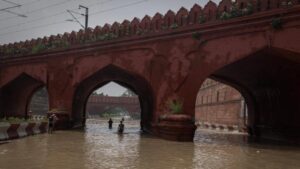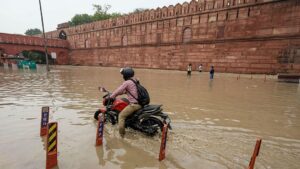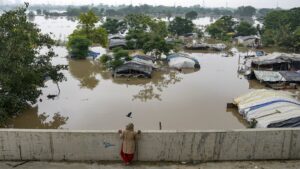The Delhi floods of July 2023 were a major disaster with the Yamuna River breaching a 45-year-high water level, submerging large parts of the city. While heavy rainfall in the upstream regions was a primary trigger, a confluence of other factors turned a natural event into a significant urban crisis. The floods caused widespread disruption, damaging infrastructure, and displacing thousands of people. The disaster highlighted systemic vulnerabilities and prompted a reevaluation of the city’s flood management strategies.
Causes of the Floods
The 2023 floods were not simply a result of a single cause but rather a combination of meteorological and human-made factors that amplified the disaster impact.


The increasing frequency of floods has raised concerns due to climate change, shifts in rainfall patterns, soil erosion leading to siltation, and the impacts of unplanned development in river areas. In July 2023, heavy rainfall caused severe flooding in Delhi NCR, resulting in the Yamuna River reaching a 45-year high water level.
Heavy Rainfall
The immediate cause was the unprecedented heavy rainfall in the Yamuna’s upper catchment area, particularly in Himachal Pradesh, Uttarakhand, and Haryana. This led to a massive discharge of water from the Hathnikund barrage into the Yamuna River. While water release from the barrage is a routine procedure during the monsoon, the sheer volume in a short period overwhelmed the river’s capacity.
Encroachment on the Floodplain
The most significant long-term contributor to the severity of the floods is the rampant encroachment on the Yamuna floodplain. The floodplain is a natural area for the river to spread out during high-flow periods, acting as a crucial buffer. However, over the decades, a significant portion of this land has been illegally occupied by both permanent structures and informal settlements. This has reduced the river’s carrying capacity, forcing the water to rise and overflow into urban areas. This is a clear case of a “man-made disaster” compounding a natural event.
Siltation and Poor Drainage
The accumulation of silt and solid waste has raised the riverbed, further reducing the Yamuna’s flow capacity. Additionally, Delhi’s drainage system is often clogged with garbage and construction and demolition (C&D) waste, impeding the proper flow of rainwater and contributing to waterlogging.

Impact on the City
The floods had a devastating and far-reaching impact on Delhi’s infrastructure and public life.
Infrastructure Damage
Key infrastructure, including roads, bridges, and essential services, was severely affected. The arterial Ring Road and areas like Pragati Maidan and Civil Lines were inundated, bringing traffic to a standstill. The flooding of water treatment plants disrupted the city’s water supply. Electricity was cut off in many areas to prevent electrocution, impacting daily life.
Public Life and Displacement
Thousands of people, particularly those in low-lying settlements and flood-prone villages, were displaced. Many were forced to take refuge in relief camps, often without adequate sanitation or resources. The floods disproportionately affected vulnerable communities, like daily wage earners and migrants, who lost their homes and livelihoods.
Response and Solutions
In the aftermath of the floods, the government and other agencies launched a multi-pronged response.
Immediate Response
The National Disaster Response Force (NDRF) and the Indian Army, along with the Delhi government, carried out large-scale rescue and evacuation operations. Relief camps were set up to provide temporary shelter, food, and medical aid to the displaced population. Efforts were also focused on restoring essential services like water and electricity.
Long-Term Solutions
The floods have spurred a more proactive approach to flood management. Authorities are now focusing on both structural and non-structural measures:
• Strengthening Infrastructure: This includes reinforcing flood regulators (iron gates on drains) to prevent backflow from the Yamuna and desilting major drains to improve water flow.
• Removing Encroachments: There’s a renewed push to reclaim the Yamuna floodplain by demolishing illegal structures. This is a crucial step to restore the river’s natural flood-buffering capacity.
• Improving Forecasting: Better coordination with the Central Water Commission and the use of technology like telemetry systems for real-time water level monitoring are being implemented.
• Public Awareness: Educating citizens about the importance of not encroaching on floodplains and proper waste disposal is also a key part of the long-term strategy.
The Delhi floods of 2023 were a sobering reminder of the consequences of unchecked urbanization and environmental neglect. The disaster underscores the urgent need for a holistic and sustainable approach to urban planning that respects the natural course of rivers and ecosystems.
